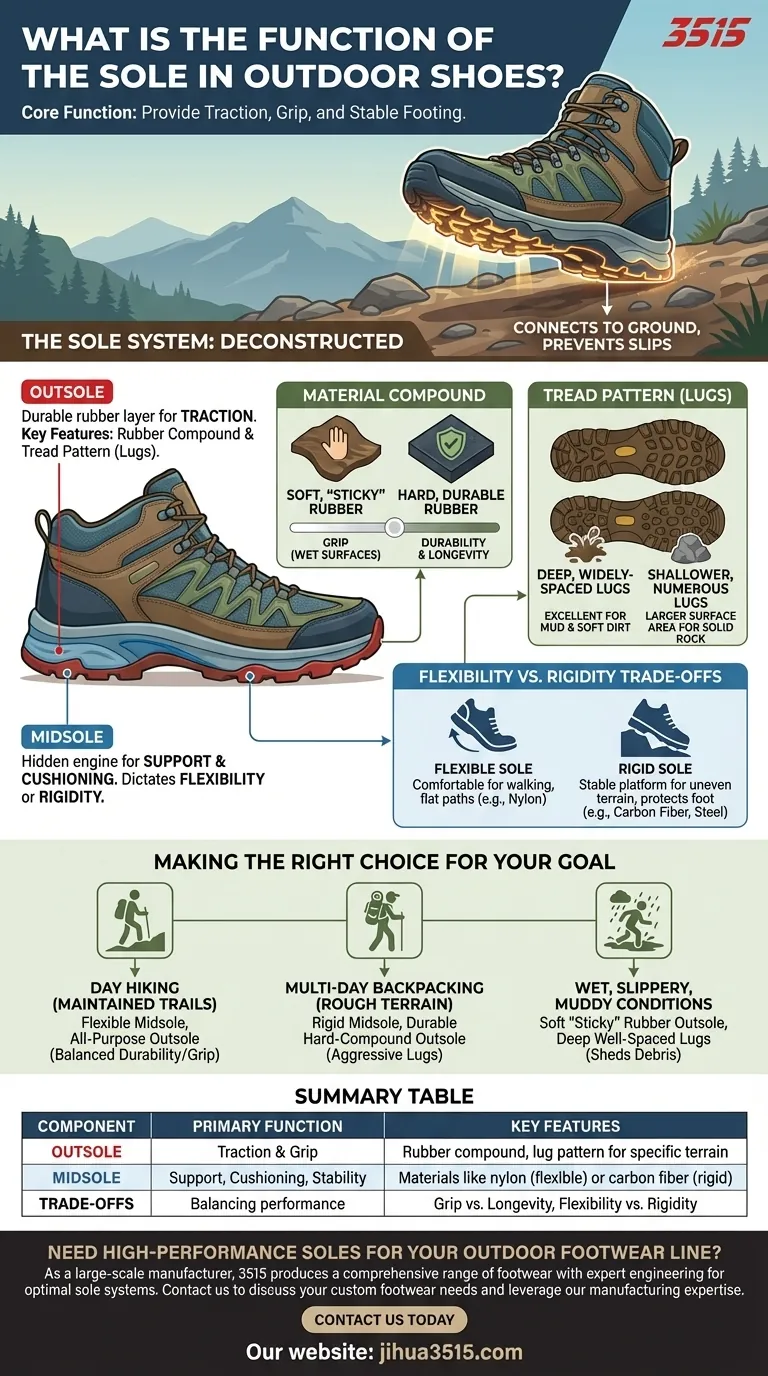At its core, the function of an outdoor shoe's sole is to provide traction and grip. This is what connects you to the ground, preventing slips and ensuring stable footing across varied and unpredictable terrain. The design and materials of the sole dictate how well the shoe performs on surfaces ranging from dry rock and packed dirt to wet mud and loose gravel.
The term "sole" actually refers to a system, primarily the outsole for grip and the midsole for support and cushioning. Understanding how these two components work together is the key to selecting the right shoe for your specific outdoor needs.

Deconstructing the Sole System
Most people think of the sole as the single rubber piece on the bottom of a shoe. In reality, it's a layered system where each part has a distinct and critical job.
The Outsole: Your Connection to the Ground
The outsole is the durable rubber layer that makes direct contact with the trail. Its primary job is to generate traction, preventing you from slipping.
This is achieved through two key features: the rubber compound and the tread pattern, often called lugs.
The Midsole: The Hidden Engine of Support
Located between the outsole and your foot, the midsole is the powerhouse of the shoe. It dictates the shoe's flexibility or rigidity, which is crucial for comfort and performance.
Midsoles made of materials like nylon provide flexibility for easy walking, while those reinforced with stiffer materials like carbon fiber or steel offer rigidity needed for challenging mountain terrain.
Key Elements of Outsole Performance
The effectiveness of an outsole comes down to the interplay between its material and its physical design.
Material Compound: The Grip vs. Durability Equation
The type of rubber used in the outsole defines its fundamental properties. Softer rubber compounds are "stickier" and provide excellent grip, especially on wet rock, but they tend to wear out more quickly.
Conversely, harder rubber compounds are far more durable and last longer, but they can feel slick and less secure on smooth, wet surfaces.
Tread Pattern (Lugs): Designing for Terrain
Lugs are the protruding shapes and patterns on the outsole. The design of these lugs is tailored to specific environments.
Deep, widely-spaced lugs are excellent for shedding mud and soft dirt. Shallower, more numerous lugs provide a larger surface area for gripping solid rock.
Understanding the Trade-offs
Choosing the right sole is always a matter of balancing competing characteristics. There is no single "best" sole, only the best one for a specific purpose.
Flexibility vs. Rigidity
A flexible sole is comfortable for walking on flat, predictable paths because it allows your foot to roll and push off naturally.
A rigid sole is essential on uneven, rocky terrain. It creates a stable platform that protects your foot from sharp objects and reduces fatigue on long ascents or when carrying a heavy pack.
Grip vs. Longevity
The choice between a soft, grippy rubber and a hard, durable one is a classic trade-off. If your primary concern is maximum security on slippery terrain, you will likely sacrifice some lifespan on the outsole. If you need a shoe for long-distance trekking on varied but less technical ground, durability becomes more important.
Making the Right Choice for Your Goal
By understanding this system, you can choose a shoe based on its intended use, not just its appearance.
- If your primary focus is day hiking on maintained trails: You need a flexible midsole for comfort and an all-purpose outsole that balances durability and grip.
- If your primary focus is multi-day backpacking on rough terrain: You need a rigid midsole for support and a durable, hard-compound outsole with aggressive lugs.
- If your primary focus is navigating wet, slippery, or muddy conditions: You need a soft, "sticky" rubber outsole with deep, well-spaced lugs designed to shed debris effectively.
Ultimately, understanding the sole empowers you to choose the right tool for your adventure.
Summary Table:
| Component | Primary Function | Key Features |
|---|---|---|
| Outsole | Provides traction and grip | Rubber compound, lug pattern for specific terrain |
| Midsole | Offers support, cushioning, and stability | Materials like nylon (flexible) or carbon fiber (rigid) |
| Trade-offs | Balancing performance characteristics | Grip vs. Longevity, Flexibility vs. Rigidity |
Need high-performance soles for your outdoor footwear line?
As a large-scale manufacturer, 3515 produces a comprehensive range of footwear for distributors, brand owners, and bulk clients. Our production capabilities encompass all types of shoes and boots, with expert engineering for optimal sole systems tailored to your market—from grippy hiking boots to durable trekking shoes.
Contact us today to discuss your custom footwear needs and leverage our manufacturing expertise.
Visual Guide

Related Products
- Durable Rubber-Soled Utility Shoes for Wholesale & Custom Brand Manufacturing
- Factory-Direct Wholesale Canvas Boots with High-Traction Rubber Soles
- Safety Footwear Wholesale Manufacturer for Custom OEM/ODM Production
- Premium Safety Shoes with Rotating Buckle Safety Sneakers
- Wholesale Modern Comfort Shoes with Dial Closure for Private Label & Bulk Orders
People Also Ask
- What makes rubber sole shoes an economical and practical choice? Unmatched Durability & All-Weather Value
- What are the benefits of rubber work shoes? Unbeatable Protection for Wet & Demanding Jobs
- What is vulcanized rubber and why is it used in products? The Key to Durable, Flexible Footwear
- What are the main applications of vulcanized rubber? Unlock Durability for Tires, Footwear & More
- What are rubber soled shoes? The Ultimate Guide to Durable, All-Weather Footwear



















